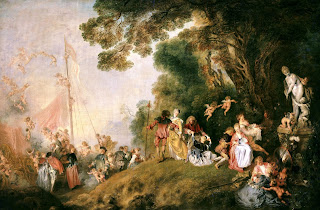Louis XIV employed academicians as his court painters, such as Poussin, of whom I wrote about here. During Louis XV's reign however, the influence of the low countries meant that French painting changed direction. Although Louis XV patronised this new style, the academicians still held their ground. The academicians, known as the 'Poussinists' were rivals of the Rubenists - those of whom followed (or painted with influence from ) the 17th century Flemish painter.
Some artists that could be described as 'Rubenists' that introduced the Rococo style:
Watteau, Embarkation for the Island of Cythera, 1717.
The island of Cythera was known as the island of Venus. The painting is dream-like, with a particularly Venetian palette. The wistfulness of the figures and the less precise brushwork has clearly been lifted from Rubens' Garden of Love (pictured below). The dimensions of this picture are 1.3m x 1.9m which is typically quite big for paintings that fell outside of the history painting genre. It is without a religious or moral meaning but is a 'fete galante' - which was basically a French party during the regency. Because of the difficulty in attributing it to a genre, the 'fete galante' became a genre of its own.
Pierrot, 1718-20.
During the reign of Louis XIV, Watteau was employed by the painter Claude Gillot whose paintings were a reaction against academic art. Here he was able to see a lot of Rubens' work but more importantly with reference to this painting he became well acquainted with characters from the 'Commedia dell'arte'. The 'comedy of craft' was a set genre of theatre which was expelled from France at the beginning of the 18th century and of which Pierrot was a character. My lecturer always says that we are 'children of the romantic era' and tend to assume paintings like this show sadness and loneliness, but he believes that may not be the case - maybe just a painting of one of his favourite characters.
Fetes Venitiennes, 1718-19.
This painting depicts Watteau's friend, and art dealer, Vleughels. He is the one in the turban. The palette is of course Venetian once more. The people in the painting are happy, flirting and listening to music. There is a sense of sensuality and harmony typical of the Rococo. Watteau has also painted a life-like sculpture to the right. The brushwork is again loose and sketchy like Rubens.
L'enseigne de Gersaint, 1720.
This is a painting of the art dealer Gersaint's shop. As above, the interaction between the figures is plentiful and flirtatious. This is quite symbolic as a change in artistic tendency - the figures are packing away austere, baroque art into boxes.
Boucher, the Rising and Setting of the Sun, 1752-3.
This one shows a slight return to moral painting. The characters are perhaps representative of Louis XV and Madame Pompadour. Louis XV as apollo is perhaps an allusion to his relation with the 'sun king' (Louis XIV). It is a baroque-ish subject mattere with baroque-ish harsh movement. Saying that, it's baroque qualities have been rococo-fied in its beauty, easy and sense of calm.
Mile O'Murphy, 1752.
My lecturer talks a lot about being able to identify different art styles through 'tits & bums' - Rococo bums are not as sculpterly as renaissance or baroque bums but not as dimplely (lol) or flat as avant-garde bums. Her foot laying of a fluffy pillow is probably meant to echo her fluffy rococo bum and is typically playful as was rococo art. With the unmistakable pinkish-orangey tones.
Frangonard, The Swing, 1767.
Hogarth's secret of beauty was that it 'leads the eye a wanton kind of chase' - i would say this applies here. She has a slipper flying off, there's a curling tree branch over her head and of course she is on a swing - a sense of letting go and being at ease.
Coresus Sacrificing Himself to Save Callirhoe, 1767.
Perhpas at first this doesn't look as calm and at ease as the others, but the little putti to the right and the way in which the sacrifice could be mistaken for something other than killing yourself are tell-tale signs of rococo.
Chardin, the Young Schoolmistress, 1735-40.
This looks like Dutch genre scenes but the refined and Venetian brushtroke gives it the quality of the French rococo. Although Chardin was influenced by the Dutch and Venetian like the other rococo painters, his work is characterised by the sense of Bourgeoisie morality that he perhaps picked up from the Netherlands too. It wasn't like the baroque whereby the sense of morality was geared towards the upper class of whom concerned themselves with dangerous, unorthodox pit-falls. It was about life, and the need to be learned for example. In rococo style though, the schoolmistress is neither harsh nor demanding - she is patient and kind.
The House of Cards, 1735-6.
This is another typical morality piece. The young boy is acting like an adult in his adult clothes, but as a house of cards may fall easily, his demeanor may deteriorate too - a lesson in acting prudent.
The Attributes of the Arts, 1766.
This obviously has a lot of still-life influence from the Dutch. Chardin wanted to be taken seriously and this was actually accepted into the academy. It shows a sculpture by his friend, Pigatte (of Mercury), books and the Order of St. Michael award that was awarded to artists.












No comments:
Post a Comment